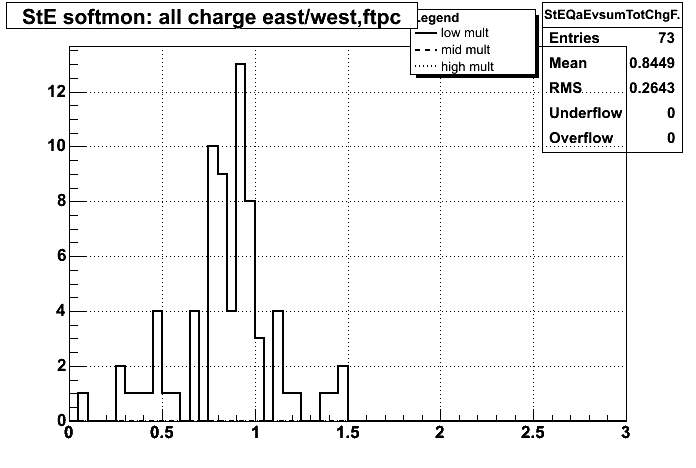 Ratio of total charge in all reconstructed clusters in FTPC
East to West for low (solid line), mid (dashed line) and low
(dotted line) multiplicity events. Should be peaked at ~1.
Ratio of total charge in all reconstructed clusters in FTPC
East to West for low (solid line), mid (dashed line) and low
(dotted line) multiplicity events. Should be peaked at ~1.
This document explains the FTPC Offline QA Shift histograms for the Year 2004 data runs. For Year 2004, the EventQA histograms are divided into a set of general histograms and one or more multiplicity class histograms. In comparing the following page numbers and plots to what you have in the actual QA postscript files for your specific QA job, you will notice that things may not match page-by-page. The actual set of QA histograms generated during reconstruction depends on the set of Makers which are active in the chain. However, all plots in the EventQA files should be described here, just not in the same sequence.
The histograms shown here are for the Production MinBias run 5008019. The postscript version of the Year 2004 QA Shift histograms for this run is available in General Hists and in Multipilicity Class Hists. For run 5008019 almost all the FTPC electronics were still working so these histograms are the "best case" histograms for 2004.
The offline QA histograms are used to monitor the calibration corrections and the
cluster and track finding parameters which are used in reconstruction.
Please report significant changes to the FTPC mailing list: ftpc-hn@www.star.bnl.gov
Janet Seyboth, Max-Planck-Institute for Physics, Munich, Germany
October 15, 2004
(Produced from Lanny Ray's original file)
 Ratio of total charge in all reconstructed clusters in FTPC
East to West for low (solid line), mid (dashed line) and low
(dotted line) multiplicity events. Should be peaked at ~1.
Ratio of total charge in all reconstructed clusters in FTPC
East to West for low (solid line), mid (dashed line) and low
(dotted line) multiplicity events. Should be peaked at ~1.
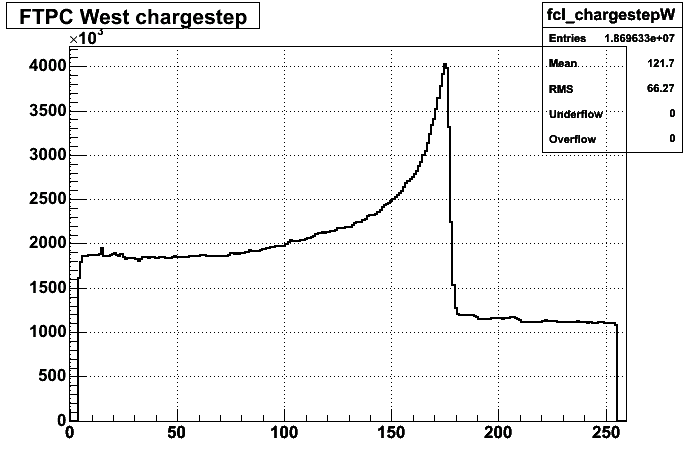 The real chargestep corresponds to the maximum drift time in FTPC West
(clusters from inner radius electrode) and is located near 170 timebins.
This position will change slightly with atmospheric pressure. The hits
beyond the step at timebin 170 are due to electronic noise. This step
should always be visable even if it is only a "blip".
The real chargestep corresponds to the maximum drift time in FTPC West
(clusters from inner radius electrode) and is located near 170 timebins.
This position will change slightly with atmospheric pressure. The hits
beyond the step at timebin 170 are due to electronic noise. This step
should always be visable even if it is only a "blip".
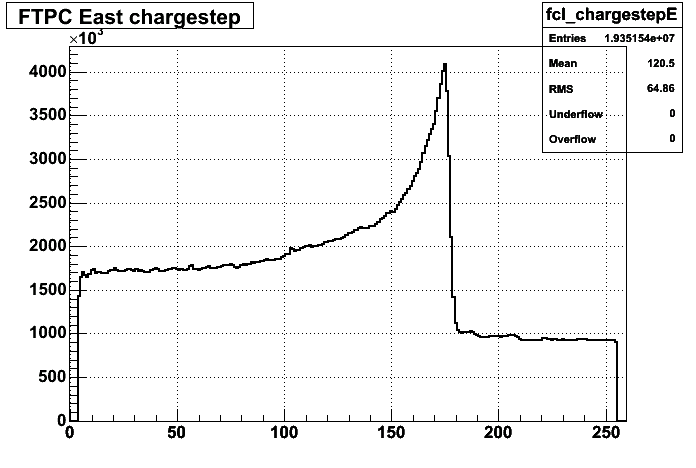 The real chargestep corresponds to the maximum drift time in FTPC East
(clusters from inner radius electrode) and is located near 170 timebins.
This position will change slightly with atmospheric pressure. The hits
beyond the step at timebin 170 are due to electronic noise. This step
should always be visable even if it is only a "blip".
The real chargestep corresponds to the maximum drift time in FTPC East
(clusters from inner radius electrode) and is located near 170 timebins.
This position will change slightly with atmospheric pressure. The hits
beyond the step at timebin 170 are due to electronic noise. This step
should always be visable even if it is only a "blip".
 The cluster radial position histogram for FTPC East(red) and FTPC West(blue) should show the radius step at the inner radius (~7.8 cm). If the temperature and pressure corrections applied to the FTPC drift maps are correct, the inflection point of the distribution of cluster radial positions will coincide with the black vertical line at 7.8 cm.
Deviations of more than 1mm (2 bins) should be reported.
The cluster radial position histogram for FTPC East(red) and FTPC West(blue) should show the radius step at the inner radius (~7.8 cm). If the temperature and pressure corrections applied to the FTPC drift maps are correct, the inflection point of the distribution of cluster radial positions will coincide with the black vertical line at 7.8 cm.
Deviations of more than 1mm (2 bins) should be reported.
 Distribution of number of reconstructed space points in
FTPC East (solid line) and West (dashed line). Should have
similar means and widths; scales with centrality,
depends on multiplicity cut for this set of plots
(i.e. low, medium or high).
Distribution of number of reconstructed space points in
FTPC East (solid line) and West (dashed line). Should have
similar means and widths; scales with centrality,
depends on multiplicity cut for this set of plots
(i.e. low, medium or high).
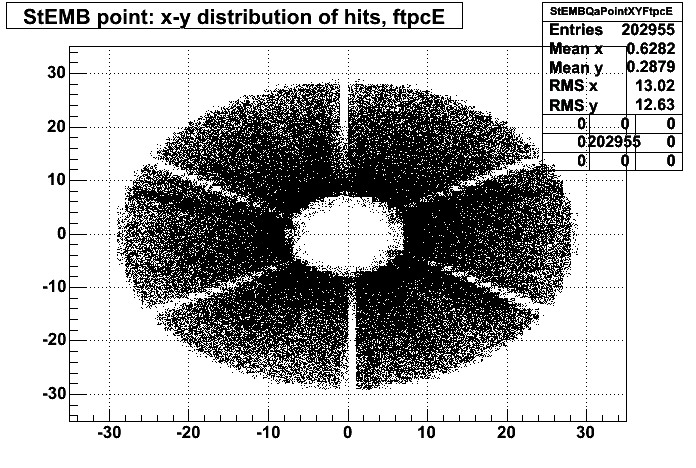 Radial distribution of reconstructed space points in FTPC East.
The distribution should be uniform. Dark areas are due to noise.
Ideally noisy pads are flagged in the FTPC gain tables so that they
are not used for cluster finding. Less densely populated areas
not on the sector boundaries are due to dead electronics. Empty areas
not on the sector boundaries indicates a serious hardware problem. An
FTPC expert should be contacted immediately if this is seen in
fast offline-QA during data taking.
Radial distribution of reconstructed space points in FTPC East.
The distribution should be uniform. Dark areas are due to noise.
Ideally noisy pads are flagged in the FTPC gain tables so that they
are not used for cluster finding. Less densely populated areas
not on the sector boundaries are due to dead electronics. Empty areas
not on the sector boundaries indicates a serious hardware problem. An
FTPC expert should be contacted immediately if this is seen in
fast offline-QA during data taking.
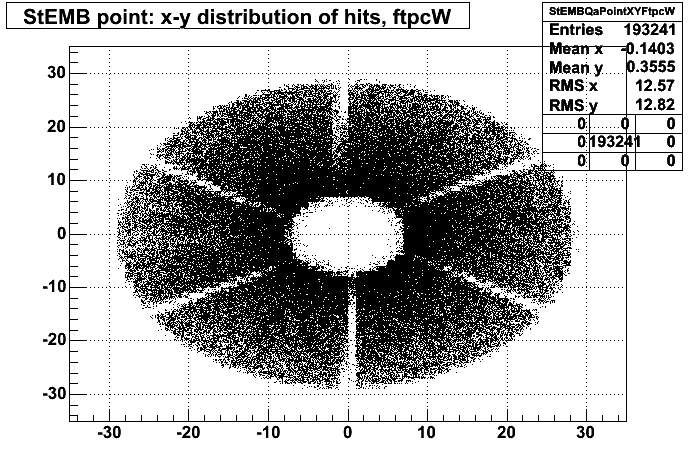 Radial distribution of reconstructed space points in FTPC West.
The distribution should be uniform. Dark areas are due to noise.
Ideally noisy pads are flagged in the FTPC gain tables so that they
are not used for cluster finding. Less densely populated areas
not on the sector boundaries are due to dead electronics. Empty areas
not on the sector boundaries indicates a serious hardware problem. An
FTPC expert should be contacted immediately if this is seen in
fast offline-QA during data taking.
Radial distribution of reconstructed space points in FTPC West.
The distribution should be uniform. Dark areas are due to noise.
Ideally noisy pads are flagged in the FTPC gain tables so that they
are not used for cluster finding. Less densely populated areas
not on the sector boundaries are due to dead electronics. Empty areas
not on the sector boundaries indicates a serious hardware problem. An
FTPC expert should be contacted immediately if this is seen in
fast offline-QA during data taking.
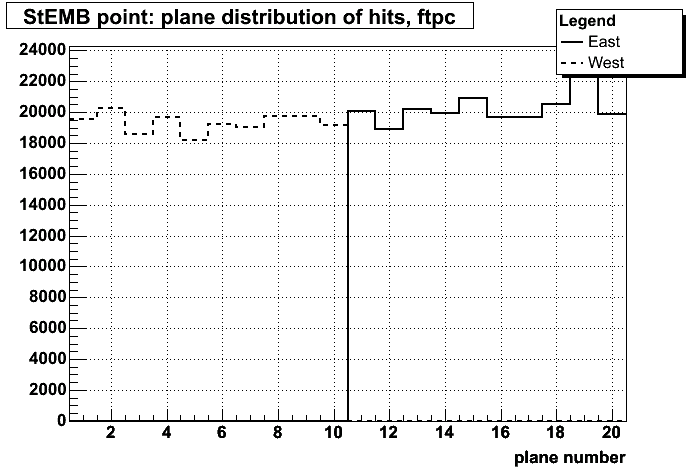 Distribution of reconstructed space points assigned to
tracks in FTPC East (solid line) and West (dashed line) with respect
to padrow number. The horizontal axis shows padrow numbers
where FTPC-West is 1-10 and FTPC-East is 11-20. Pads
#1 and #11 are closest to the center of STAR. East and West should
be similar in shape and magnitude.
Spikes indicate noisy electronics; dips indicate dead electronics.
Distribution of reconstructed space points assigned to
tracks in FTPC East (solid line) and West (dashed line) with respect
to padrow number. The horizontal axis shows padrow numbers
where FTPC-West is 1-10 and FTPC-East is 11-20. Pads
#1 and #11 are closest to the center of STAR. East and West should
be similar in shape and magnitude.
Spikes indicate noisy electronics; dips indicate dead electronics.
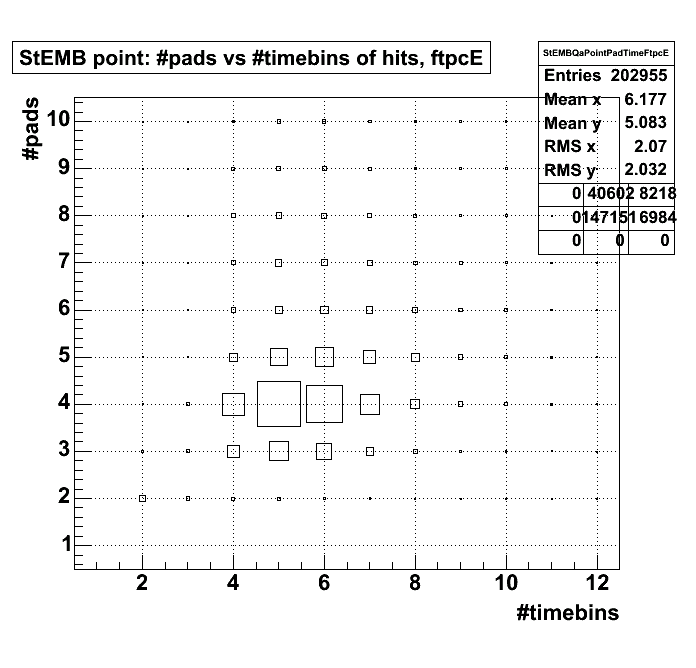 Monitors the cluster reconstruction in FTPC East. Ideally the
reconstructed clusters should have a pad length of 3-5 and a
timebin length of 4-6. Peaks located at (2,2) indicate noise.
Monitors the cluster reconstruction in FTPC East. Ideally the
reconstructed clusters should have a pad length of 3-5 and a
timebin length of 4-6. Peaks located at (2,2) indicate noise.
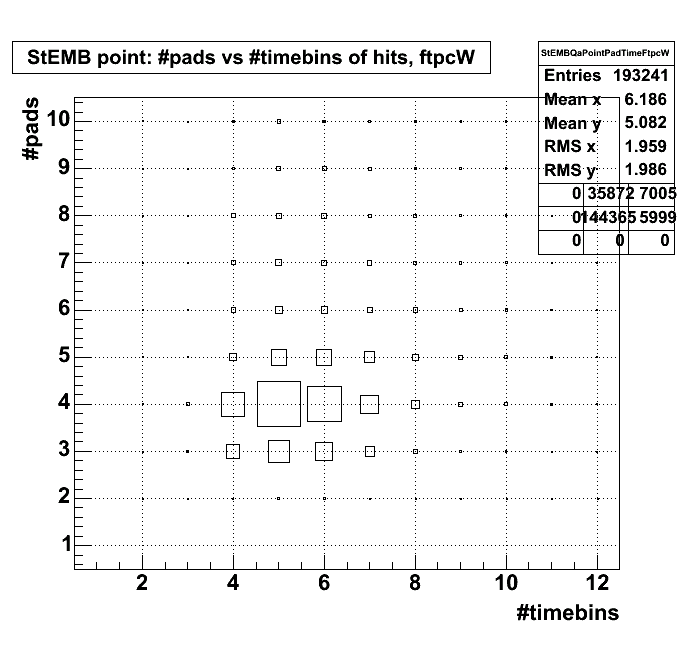 Monitors the cluster reconstruction in FTPC West. Ideally the
reconstructed clusters should have a pad length of 3-5 and a
timebin length of 4-6. Peaks located at (2,2) indicate noise.
Monitors the cluster reconstruction in FTPC West. Ideally the
reconstructed clusters should have a pad length of 3-5 and a
timebin length of 4-6. Peaks located at (2,2) indicate noise.
 Scatter plot of good global track multiplicities in FTPC West
versus FTPC East. Distribution should be correlated and lie
along the diagonal reference line. Magnitudes and widths depend on
trigger condition and multiplicity cut for this
set of plots (i.e. low, medium or high).
Scatter plot of good global track multiplicities in FTPC West
versus FTPC East. Distribution should be correlated and lie
along the diagonal reference line. Magnitudes and widths depend on
trigger condition and multiplicity cut for this
set of plots (i.e. low, medium or high).
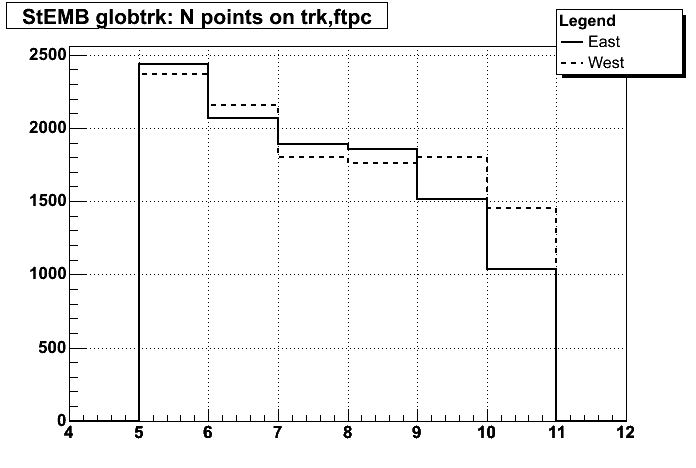 Distribution of the number of fitted points on track
for FTPC-East (solid line) and FTPC-West (dashed line)
global tracks. Distributions should be similar within
statistics and peak at 10.
For year 2004 data, the distributions peak at 5 instead of 10.
This indicates that the cluster and track finding parameters need
tuning. We are working on this.
Distribution of the number of fitted points on track
for FTPC-East (solid line) and FTPC-West (dashed line)
global tracks. Distributions should be similar within
statistics and peak at 10.
For year 2004 data, the distributions peak at 5 instead of 10.
This indicates that the cluster and track finding parameters need
tuning. We are working on this.
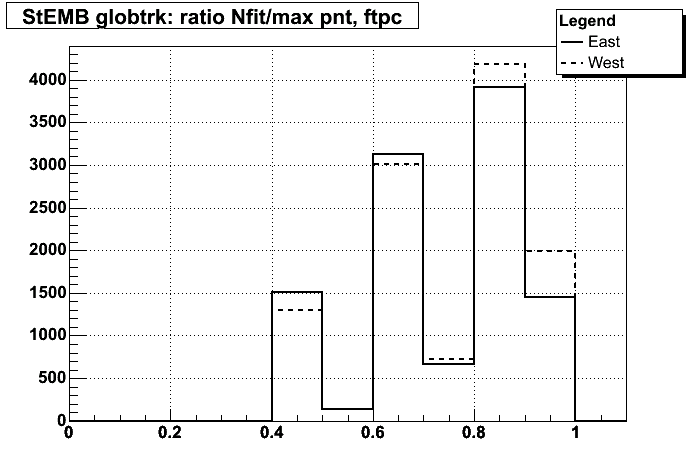 Ratio of number of fitted points to estimated maximum
number for FTPC-East (solid line) and FTPC-West (dashed line) global
tracks. Should peak at ~1. Distributions should be
similar within statistics.
Ratio of number of fitted points to estimated maximum
number for FTPC-East (solid line) and FTPC-West (dashed line) global
tracks. Should peak at ~1. Distributions should be
similar within statistics.
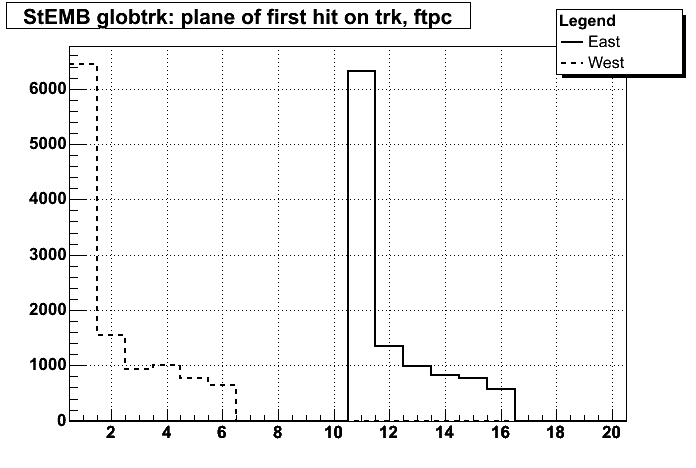 Distribution of first fitted space point with respect to
FTPC pad row number (West is 1-10, dashed line; East is
11-20, solid line) for FTPC global tracks. These should be
similar within statistics and peak at pad rows 1 and 11.
Distribution of first fitted space point with respect to
FTPC pad row number (West is 1-10, dashed line; East is
11-20, solid line) for FTPC global tracks. These should be
similar within statistics and peak at pad rows 1 and 11.
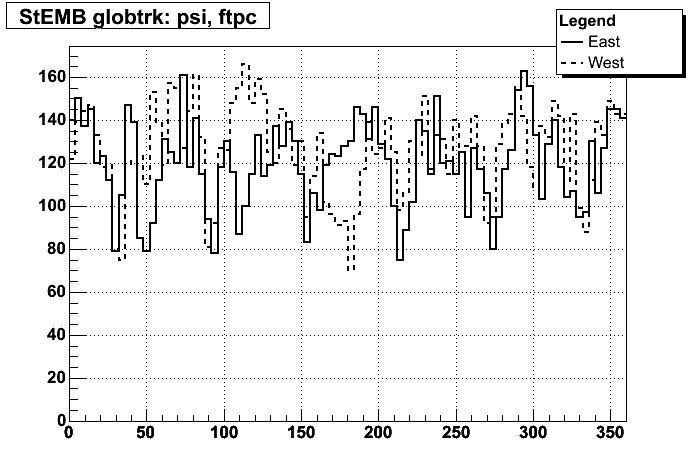 Azimuthal distributions for track direction angle (psi) for
FTPC-East (solid line) and FTPC-West (dashed line) global tracks.
These should be similar and flat within statistics except for
the hexagonal FTPC sector structure which is visible at 30,90,150,210,270 and 330 degrees.
Holes are due to dead electronics.
Azimuthal distributions for track direction angle (psi) for
FTPC-East (solid line) and FTPC-West (dashed line) global tracks.
These should be similar and flat within statistics except for
the hexagonal FTPC sector structure which is visible at 30,90,150,210,270 and 330 degrees.
Holes are due to dead electronics.
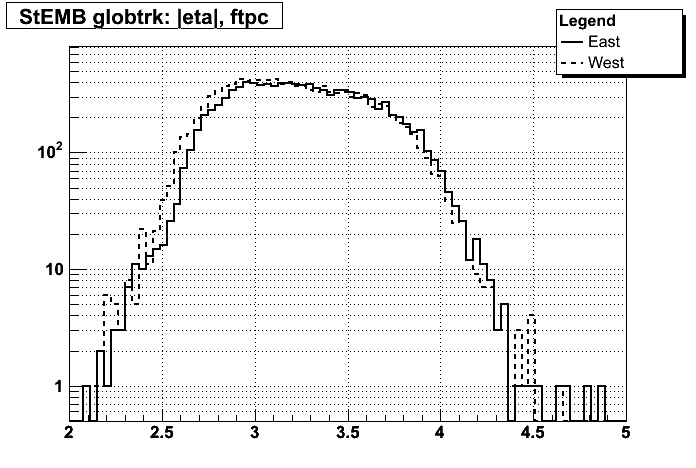 Distributions of absolute value of pseudorapidity for
FTPC-East (solid line) and FTPC-West (dashed line) global tracks.
These should be similar within statistics and range from about
2.5 to 4.
Distributions of absolute value of pseudorapidity for
FTPC-East (solid line) and FTPC-West (dashed line) global tracks.
These should be similar within statistics and range from about
2.5 to 4.
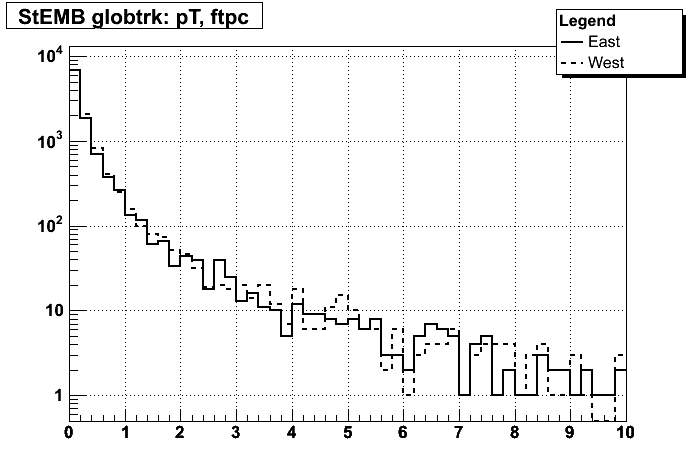 Transverse momentum (GeV/c) distributions for
FTPC-East (solid line) and FTPC-West (dashed line) global tracks.
These should be similar within statistics.
Transverse momentum (GeV/c) distributions for
FTPC-East (solid line) and FTPC-West (dashed line) global tracks.
These should be similar within statistics.
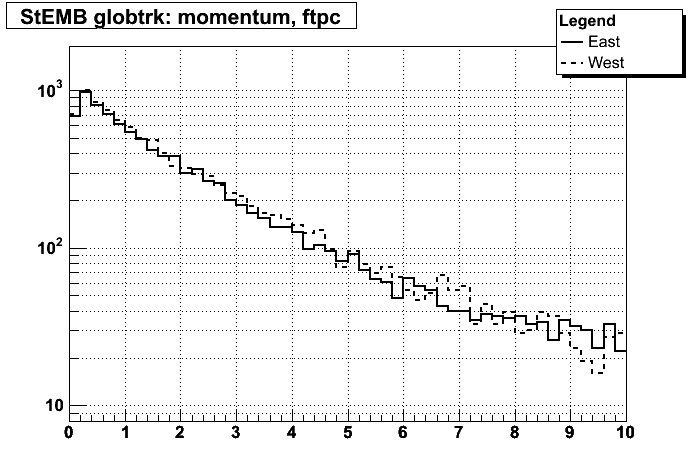 Total momentum (GeV/c) distributions for
FTPC-East (solid line) and FTPC-West (dashed line) global tracks.
These should be similar within statistics.
Total momentum (GeV/c) distributions for
FTPC-East (solid line) and FTPC-West (dashed line) global tracks.
These should be similar within statistics.
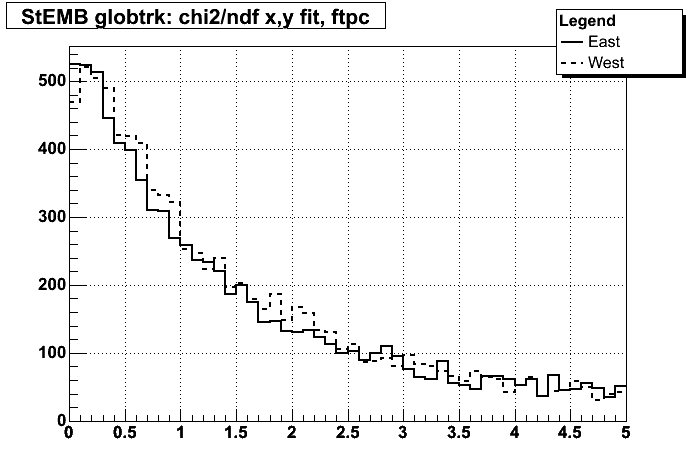 Chi squared per degrees of freedom for the x,y fit for global tracks in FTPC-East (solid line) and FTPC-West (dashed line).
Chi squared per degrees of freedom for the x,y fit for global tracks in FTPC-East (solid line) and FTPC-West (dashed line).
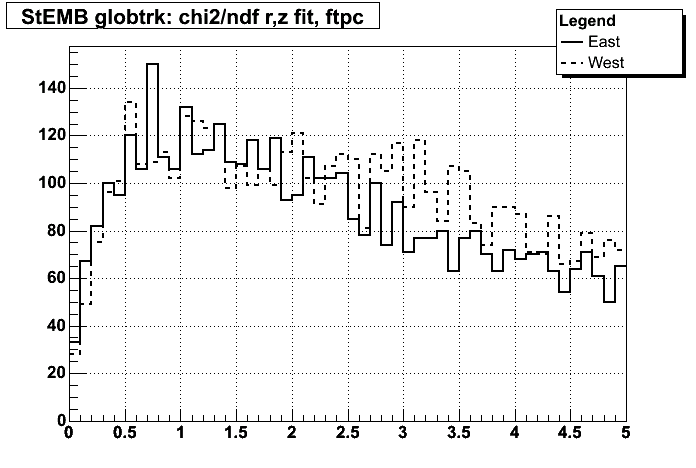 Chi squared per degree of freedom for the r,z fit for global tracks in FTPC-East (solid line) and FTPC-West (dashed line).
Chi squared per degree of freedom for the r,z fit for global tracks in FTPC-East (solid line) and FTPC-West (dashed line).
 Impact parameter (in cm) from primary vertex for
FTPC-East (solid line) and FTPC-West (dashed line) global tracks.
These should be similar within statistics.
Impact parameter (in cm) from primary vertex for
FTPC-East (solid line) and FTPC-West (dashed line) global tracks.
These should be similar within statistics.
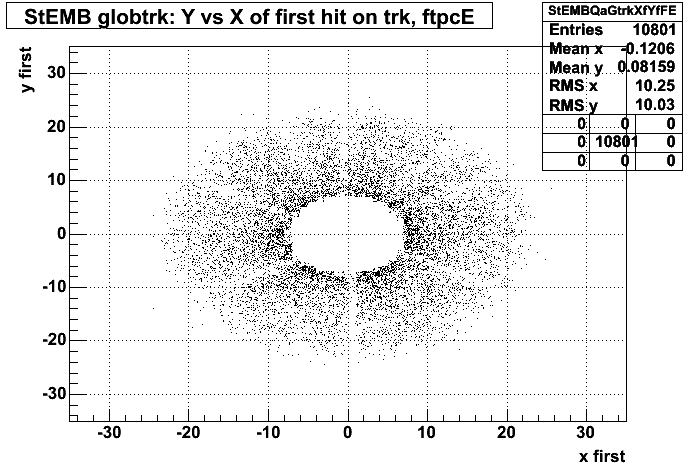 Scatter plot of (x,y) coordinates for the first fitted
space points in FTPC-East global tracks.
These should be uniformly populated
with hits; FTPC hexagonal structure is apparent.
Scatter plot of (x,y) coordinates for the first fitted
space points in FTPC-East global tracks.
These should be uniformly populated
with hits; FTPC hexagonal structure is apparent.
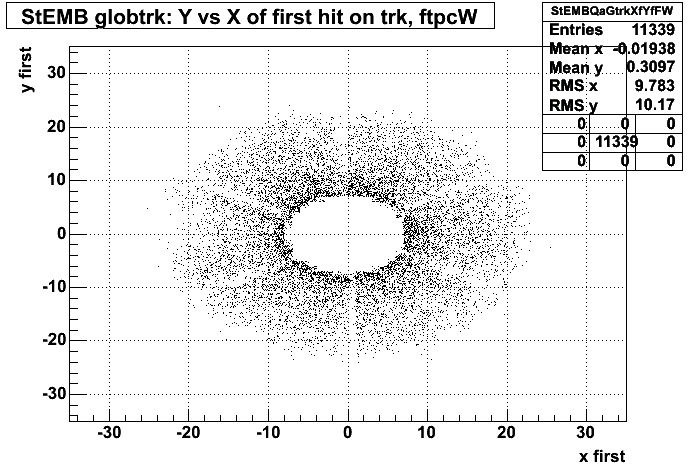 Scatter plot of (x,y) coordinates for the first fitted
space points in FTPC-West global tracks.
These should be uniformly populated
with hits; FTPC hexagonal structure is apparent.
Scatter plot of (x,y) coordinates for the first fitted
space points in FTPC-West global tracks.
These should be uniformly populated
with hits; FTPC hexagonal structure is apparent.
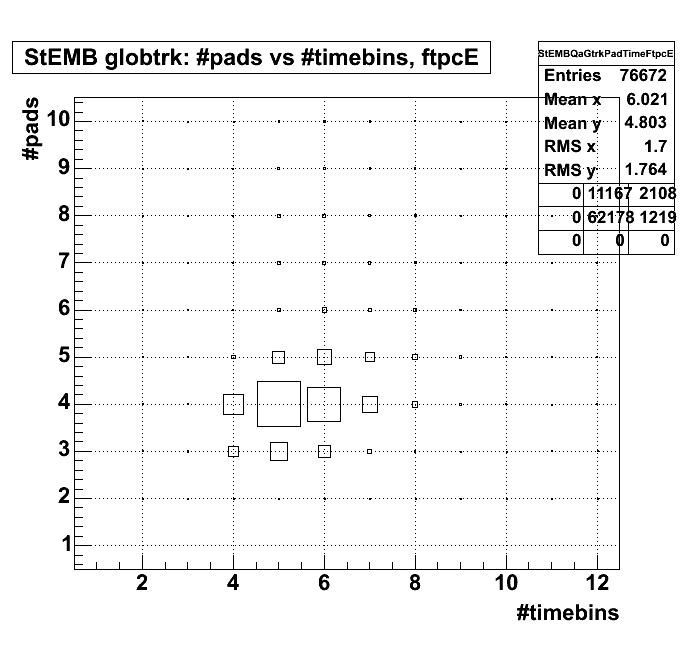 Monitors track finding in FTPC East. Ideally the clusters on
tracks should have a pad length of 3-5 and a
timebin length of 4-6
Monitors track finding in FTPC East. Ideally the clusters on
tracks should have a pad length of 3-5 and a
timebin length of 4-6
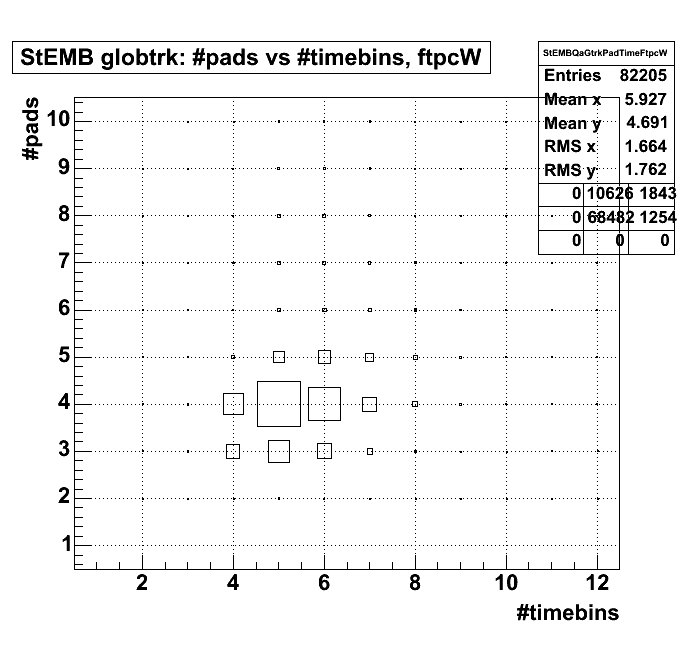 Monitors track finding in FTPC West. Ideally the clusters on
tracks should have a pad length of 3-5 and a
timebin length of 4-6
Monitors track finding in FTPC West. Ideally the clusters on
tracks should have a pad length of 3-5 and a
timebin length of 4-6
 Scatter plot of good primary track multiplicities in FTPC West
versus FTPC East. Distribution should be correlated and lie
along the reference diagonal line. Magnitudes and widths depend on
trigger condition and multiplicity cut for this
set of plots (i.e. low, medium or high).
Scatter plot of good primary track multiplicities in FTPC West
versus FTPC East. Distribution should be correlated and lie
along the reference diagonal line. Magnitudes and widths depend on
trigger condition and multiplicity cut for this
set of plots (i.e. low, medium or high).
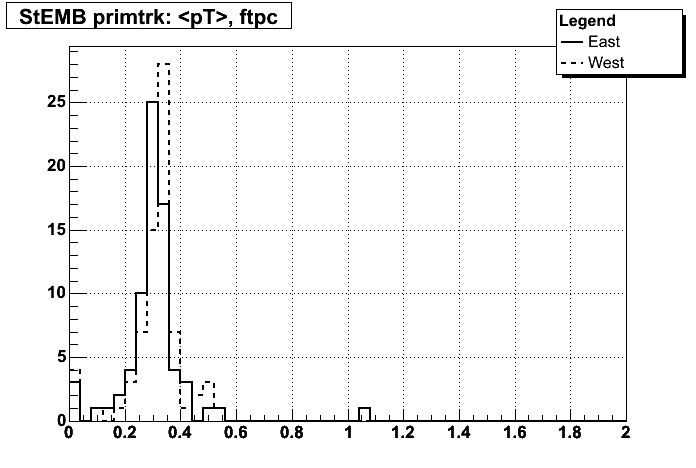 Mean transverse momentum distribution for FTPC-East (solid line)
and FTPC-West (dashed line) good primary tracks. These should be
similar within statistics and peak around 0.4 - 0.6 GeV/c but can
have broader distributions than for the SVT and TPC tracks.
Mean transverse momentum distribution for FTPC-East (solid line)
and FTPC-West (dashed line) good primary tracks. These should be
similar within statistics and peak around 0.4 - 0.6 GeV/c but can
have broader distributions than for the SVT and TPC tracks.
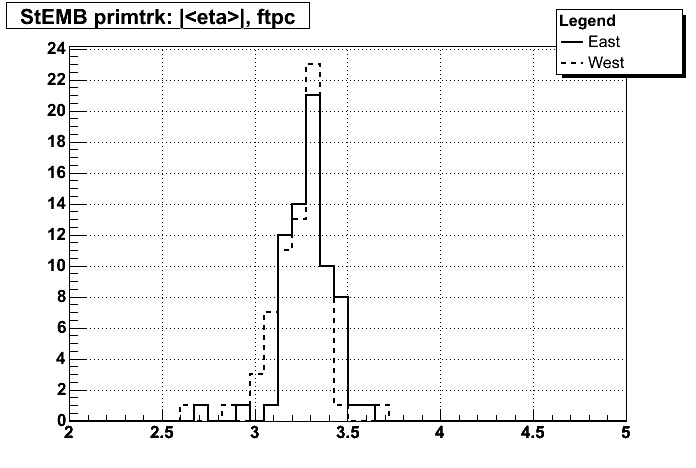 Distribution of absolute value of mean pseudorapidity for FTPC-East
(solid line) and FTPC-West (dashed line) good primary tracks.
These should be similar within statistics and peak
around 3 - 3.5.
Distribution of absolute value of mean pseudorapidity for FTPC-East
(solid line) and FTPC-West (dashed line) good primary tracks.
These should be similar within statistics and peak
around 3 - 3.5.
 Azimuthal distributions for track direction angle (psi) for
FTPC-East (solid line) and FTPC-West (dashed line) primary tracks.
These should be similar and flat within statistics except for
the hexagonal FTPC sector structure which is visible at 30,90,150,210,27
0 and 330 degrees.
Holes are due to dead electronics.
Azimuthal distributions for track direction angle (psi) for
FTPC-East (solid line) and FTPC-West (dashed line) primary tracks.
These should be similar and flat within statistics except for
the hexagonal FTPC sector structure which is visible at 30,90,150,210,27
0 and 330 degrees.
Holes are due to dead electronics.
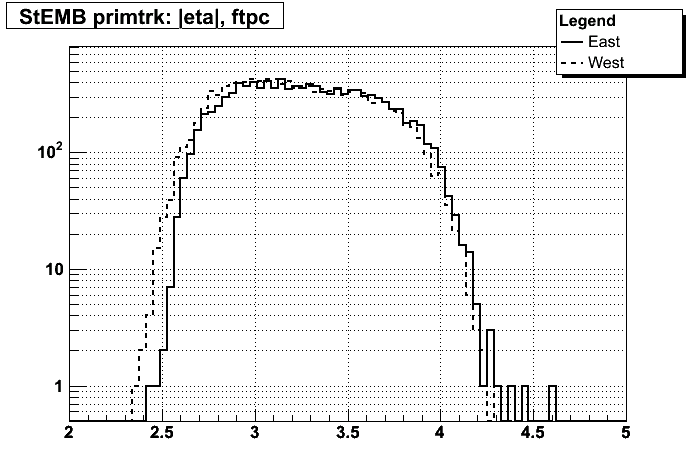 Distributions of absolute value of pseudorapidity for
FTPC-East (solid line) and FTPC-West (dashed line) primary tracks.
These should be similar within statistics and range from about
2.5 to 4.
Distributions of absolute value of pseudorapidity for
FTPC-East (solid line) and FTPC-West (dashed line) primary tracks.
These should be similar within statistics and range from about
2.5 to 4.
 Transverse momentum (GeV/c) distributions for
FTPC-East (solid line) and FTPC-West (dashed line) primary tracks.
These should be similar within statistics.
Transverse momentum (GeV/c) distributions for
FTPC-East (solid line) and FTPC-West (dashed line) primary tracks.
These should be similar within statistics.
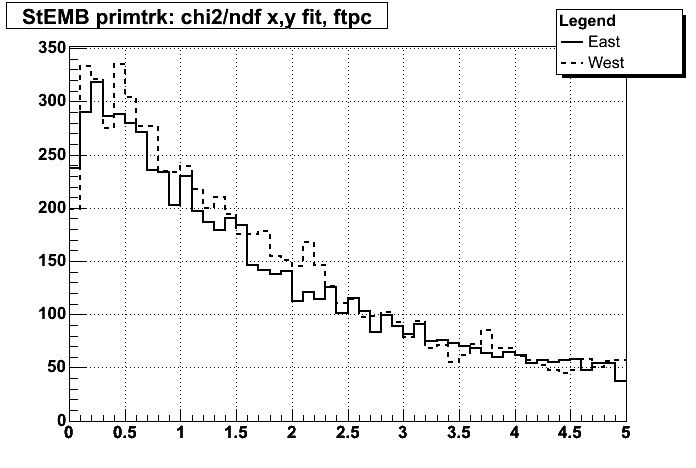 Chi squared per degree of freedom for the x,y fit for primary tracks
in FTPC-East (solid line) and FTPC-West (dashed line).
Chi squared per degree of freedom for the x,y fit for primary tracks
in FTPC-East (solid line) and FTPC-West (dashed line).
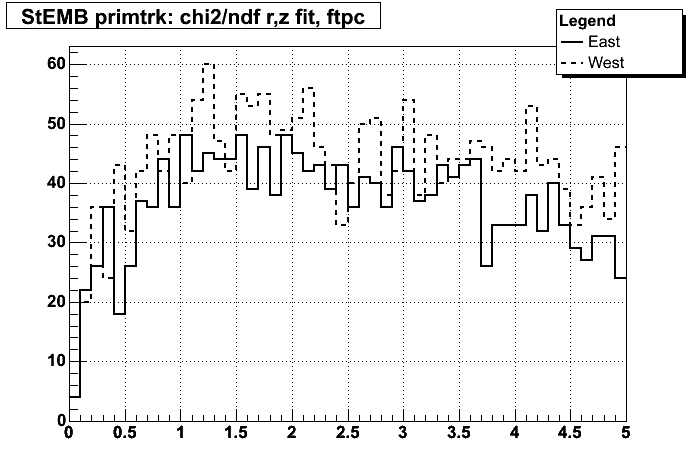 Chi squared per degrees of freedom for the r,z fit for primary tracks in FTPC-East (solid line) and FTPC-West (dashed line).
Chi squared per degrees of freedom for the r,z fit for primary tracks in FTPC-East (solid line) and FTPC-West (dashed line).
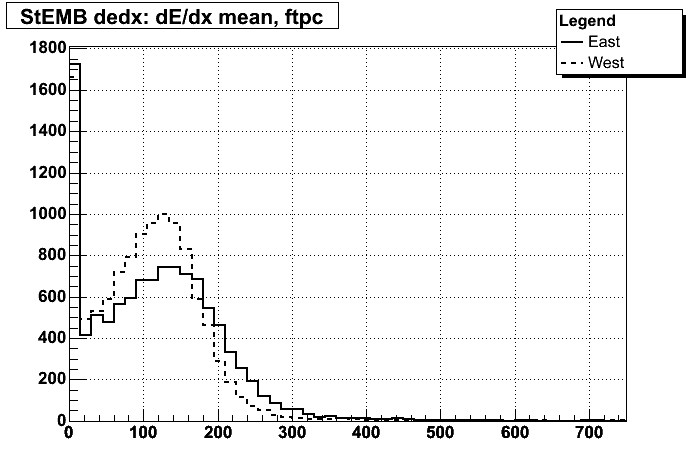 dE/dx mean FTPC-East (solid line) and FTPC-West (dashed line) primary tracks. This histogram is currently meaningless since no calibration has
been done.
dE/dx mean FTPC-East (solid line) and FTPC-West (dashed line) primary tracks. This histogram is currently meaningless since no calibration has
been done.